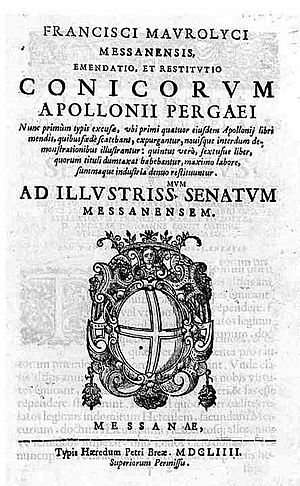Francesco Maurolico facts for kids
Quick facts for kids
Francesco Maurolico
|
|
|---|---|

Engraving of Maurolico
|
|
| Born | 1494 |
| Died | 1575 (aged 81) Messina, Kingdom of Sicily
|
| Scientific career | |
| Fields | Mathematics, geometry, optics, conics, mechanics, music, and astronomy |
Francesco Maurolico was a smart mathematician and astronomer from Sicily, which is an island in Italy. He was born in 1494 and lived until 1575.
He made many important discoveries in subjects like geometry (the study of shapes), optics (the study of light), and astronomy (the study of stars and planets). He also worked on mechanics (how things move) and music.
Francesco Maurolico also helped to edit and understand the old writings of famous thinkers like Archimedes. He wrote his own books about math and science too.
His Life Story
Francesco was born in a city called Messina in Sicily. His family name was Marulì. His father, Antonio Marulì, was a doctor from Greece who came to Sicily when the Ottoman Empire took over Constantinople.
Francesco learned a lot from his father and other teachers who followed the ideas of a famous Greek scholar named Constantine Lascaris. This helped him get a great education.
In 1534, Francesco changed his last name to Mauro Lyco. This name meant "occult wolf." He had been using a similar name, Mauro Lycio ("occult Apollo"), for eight years as part of a group in Messina.
He became a priest in 1521. Later, in 1550, he was made the abbot (a leader of a monastery) of Santa Maria del Parto. This was thanks to Simone Ventimiglia, a rich and powerful person who was also Maurolico's student.
Francesco Maurolico died in 1575 during a serious sickness called the plague. He had moved to a hilly area outside Messina to avoid the sickness. He is buried in a church in Messina. His nephews built a beautiful tomb for him there.
What He Achieved
In 1535, Maurolico helped design special arches for the Holy Roman Emperor Charles V when he visited Messina. He wrote the Latin words for these arches.
Like his father, he also worked at the mint in Messina, where coins were made. For a while, he even helped look after the city's defenses for Emperor Charles V.
Maurolico taught the sons of Juan de Vega, who was a very important leader in Sicily. He also wrote letters to other famous scholars of his time.
In 1547, he worked with a sculptor named Giovanni Angelo Montorsoli on the famous Orion Fountain in Messina. Maurolico wrote the Latin words on the fountain and likely helped plan its design.
Between 1548 and 1550, he stayed at a castle in Pollina, Sicily. He used the castle's tower to watch the stars and planets.
One of his important observations was seeing a supernova (a very bright exploding star) in 1572. This supernova appeared in the Cassiopeia group of stars. Another astronomer, Tycho Brahe, also wrote about it later.
In 1569, Francesco Maurolico became a professor at the University of Messina.
His Writings and Discoveries

- His books Photismi de lumine et umbra and Diaphana were about how light bends, which is called refraction. He tried to explain why we see a rainbow. He also studied the camera obscura, which is a simple device that projects an image using a small hole. These books were finished in the 1520s and 1550s but were published after he died in 1611.
- In a book he wrote in 1537, he described a math rule called Euler's formula for special shapes called Platonic solids. This was long before another famous mathematician, Leonhard Euler, wrote about it more generally in 1752.
- His book Arithmeticorum libri duo (1575) has the first known example of something called mathematical induction. This is a way to prove that a math statement is true for all numbers.
- In his book De momentis aequalibus (finished in 1548, published in 1685), he tried to figure out the center of gravity for different shapes like pyramids.
- He wrote a history book about Sicily called Sicanicarum rerum compendium. It also included some details about his own life. The city of Messina paid him to write this book.
- In his book De Sphaera Liber Unus (1575), he strongly disagreed with Copernicus' idea that the Earth goes around the Sun (called heliocentrism). Maurolico believed the Sun went around the Earth.
- Maurolico also wrote a book called Cosmographia. In it, he explained a way to measure the size of the Earth. This method was later used by another scientist, Jean Picard, in the 1670s.
- He edited a book by Aristotle about mechanics and wrote about music. He also made a map of Sicily, which was published in 1575.
- He worked on many old Greek math texts. He didn't just translate them, but he helped people understand them better.
Legacy
Francesco Maurolico died in Messina.
A crater on the Moon is named after him.
There is also a school in Messina that carries his name.
In 2009, the Italian government decided to create a special collection of all of Maurolico's mathematical works.
See also
 In Spanish: Francesco Maurolico para niños
In Spanish: Francesco Maurolico para niños
- Camera obscura
- Center of mass
- Commandino's theorem
- Descartes on Polyhedra
- List of Roman Catholic scientist-clerics
- Greek scholars in the Renaissance
- Mathematical induction
- Octahedral number
- Timeline of calculus and mathematical analysis


